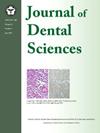口服益生菌对儿童外源性黑斑相关细菌的潜在杀菌作用:一项体外和体内研究
IF 3.1
3区 医学
Q1 DENTISTRY, ORAL SURGERY & MEDICINE
引用次数: 0
摘要
背景/目的外源性黑斑(EBS)是儿童的顽固性审美问题。本研究的目的是研究三种益生菌菌株对儿童体内和体外两种eb相关细菌的杀菌作用。材料与方法在体外实验中,将放线菌聚集菌(Aggregatibacter放线菌comitans)和naeslundii放线菌(Actinomyces naeslundii)在厌氧或嗜微氧条件下复活培养。培养物在脑心灌注肉汤中培养,调整至0.5麦克法兰标准,稀释至1.0 × 10⁶CFU/mL进行最低抑制浓度(MIC)测试。3株益生菌(唾液链球菌BLIS M18、罗伊氏乳杆菌LR08、副卡萨伊乳杆菌Lpc- 37)进行类似培养和处理,采用96孔微滴板测定MIC,采用目测和分光光度法测定细菌生长情况。在体内研究中,在给予益生菌14天之前和之后收集EBS患者未受刺激的唾液样本。用分光光度法提取微生物DNA并定量。结果在体外研究中,随着益生菌浓度的增加,细菌生长逐渐下降,证实了剂量依赖性的抑制作用。统计分析显示,与对照组相比,这两个物种的感染率均显著降低(P < 0.001),放线菌comitans表现出更强的反应。在体内研究中,放线菌被完全根除,而纳氏单胞杆菌仅被部分抑制。结论益生菌在体外和体内均能显著抑制eb相关细菌的生长,从而消除放线菌,显著减少纳氏单胞杆菌的数量。本文章由计算机程序翻译,如有差异,请以英文原文为准。
The potential bactericidal effect of oral probiotics on extrinsic black stain-associated bacteria in children: An in-vitro and in-vivo study
Background/purpose
The extrinsic black stain (EBS) is a resistant esthetic problem in children. The aim of this study was to investigate the bactericidal effect of three probiotics strains on two types of EBS-associated bacteria in-vitro and in-vivo in children.
Materials and methods
In the in-vitro study, two bacterial strains (Aggregatibacter actinomycetemcomitans and Actinomyces naeslundii) were revived and incubated under anaerobic or microaerophilic conditions. Cultures were grown in Brain Heart Infusion broth, adjusted to a 0.5 McFarland standard, and diluted to 1.0 × 10⁶ CFU/mL for minimum inhibitory concentration (MIC) testing. Three Probiotic strains (Streptococcus Salivarius BLIS M18, Lactobacillus reuteri LR08, Lactobacillus paracasei Lpc- 37) were similarly cultured and processed, and the MIC was determined using a 96-well microtiter plate, with bacterial growth assessed visually and spectrophotometrically. In the in-vivo study, unstimulated saliva samples were collected from patients with EBS before and after 14 days of probiotic administration. Microbial DNA was extracted and quantified using spectrophotometry.
Results
In the in-vitro study, bacterial growth declined progressively with increasing probiotic concentrations, confirming a dose-dependent inhibitory effect. Statistical analysis showed significant reductions for both species (P < 0.001) compared to controls, with A. actinomycetemcomitans exhibiting a stronger response. In the in-vivo study, A.actinomycetemcomitans was fully eradicated, while A. naeslundii showed only partial suppression.
Conclusion
Probiotics significantly inhibited the growth of EBS-associated bacteria in both in-vitro and in-vivo settings, resulting in the elimination of A. actinomycetemcomitans and a marked reduction in A. naeslundii count.
求助全文
通过发布文献求助,成功后即可免费获取论文全文。
去求助
来源期刊

Journal of Dental Sciences
医学-牙科与口腔外科
CiteScore
5.10
自引率
14.30%
发文量
348
审稿时长
6 days
期刊介绍:
he Journal of Dental Sciences (JDS), published quarterly, is the official and open access publication of the Association for Dental Sciences of the Republic of China (ADS-ROC). The precedent journal of the JDS is the Chinese Dental Journal (CDJ) which had already been covered by MEDLINE in 1988. As the CDJ continued to prove its importance in the region, the ADS-ROC decided to move to the international community by publishing an English journal. Hence, the birth of the JDS in 2006. The JDS is indexed in the SCI Expanded since 2008. It is also indexed in Scopus, and EMCare, ScienceDirect, SIIC Data Bases.
The topics covered by the JDS include all fields of basic and clinical dentistry. Some manuscripts focusing on the study of certain endemic diseases such as dental caries and periodontal diseases in particular regions of any country as well as oral pre-cancers, oral cancers, and oral submucous fibrosis related to betel nut chewing habit are also considered for publication. Besides, the JDS also publishes articles about the efficacy of a new treatment modality on oral verrucous hyperplasia or early oral squamous cell carcinoma.
 求助内容:
求助内容: 应助结果提醒方式:
应助结果提醒方式:


